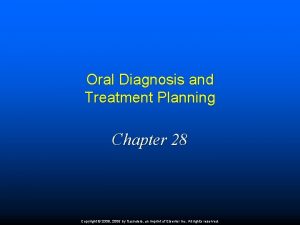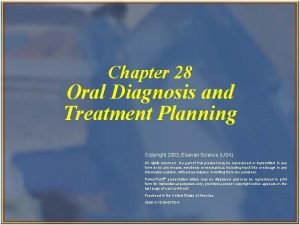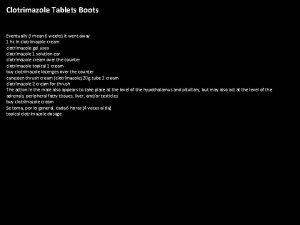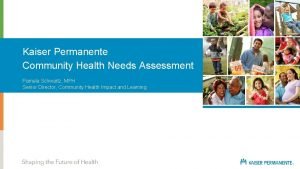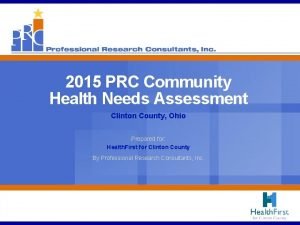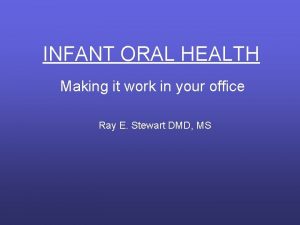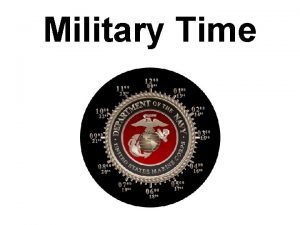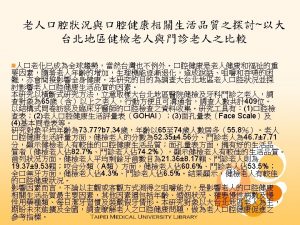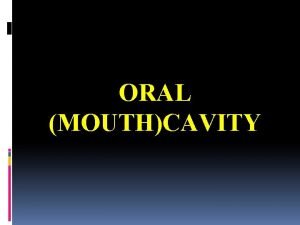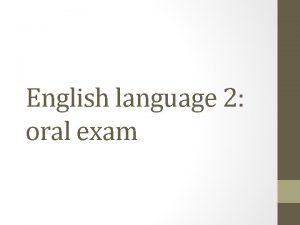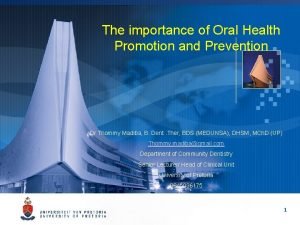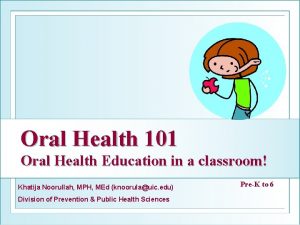Oral Health Status and Treatment Needs of Military
















- Slides: 16

Oral Health Status and Treatment Needs of Military Personnel Supported by the Pentagon Dental Clinic Andrew K. York, CAPT, DC, USN David L. Moss, LTC, USA, DC Susan W. Mongeau, Lt Col, USAF, DC Tri-Service Center for Oral Health Studies Uniformed Services University of the Health Sciences Bethesda, MD September 2003

Table of Contents Background 2 Methods 2 -3 Study Sample 3 Oral Health Status (Do. D Dental Classification) 4 Operative Treatment Needs 5 Oral Surgery (extraction) Treatment Needs 6 Endodontic Treatment Needs 7 Prosthodontic Treatment Needs 8 Periodontic Treatment Needs 9 -10 Treatment Needs Expressed as Dental Weighted Values 11 -12 Clinical Mix of Treatment Provided 13 Gross Estimation of Population Supported by the Pentagon Dental Clinic 14 Summary of Findings 15 1

Background In July 2003 the Pentagon Dental Clinic Dental Advisory Board (DAB) requested the Tri-Service Center for Oral Health Studies (TSCOHS) conduct a study to assess the oral health status and treatment needs of the military active duty personnel supported by the clinic. The Pentagon Dental Clinic is uniquely staffed by equal numbers of Air Force, Army, and Navy dental providers. The clinic’s patient base is comprised of a higher percentage of senior personnel and officers compared to most military dental clinics. This difference in population demographics may result in a mix of patient dental treatment needs and consequently treatment provided that is unlike other military dental clinics. Methods 1. Treatment Needs Assessment The total treatment requirement by a population equals the treatment provided (met treatment need) plus the unmet treatment need. The treatment provided is obtained from each service’s centralized computer database, DENCAS (Navy), DDS (Air Force), and CDA (Army). Unmet treatment need is that need which has been diagnosed but not yet treated, as found in the patient dental record. 2. Data Collection and Analysis TSCOHS dental officers extracted all oral health status and unmet treatment needs data from a systematic random sample of 442 patient dental records of Navy/Marine, Air Force, and Army personnel supported by the Pentagon Dental Clinic. Data were entered via a customized computer data entry screen designed using Microsoft Access® 2000. These data were then converted into an SPSS ® 11. 5 database for statistical analysis. 2

Methods 3. Study Sample The sampling frame for this study was the 10, 166 dental patient records available at the Pentagon Dental Clinic on 3 September 2003. This analysis reasonably assumes that these records were representative of all patients supported by the clinic. A target sample size of 450 was chosen to provide population estimates no worse than plus or minus 4%. Unmet treatment needs data from a systematic random sample comprised of every 23 rd patient dental record was collected resulting in a final sample size of 442. The sample breakouts by service and paygrade are shown in Tables 1 and 2, respectively. # SAMPLED % of SAMPLE Air Force 113 25. 6 Army 186 42. 1 Navy/Marine Corps 143 32. 3 Total 442 100. 0 Table 1 PAYGRADE # in SAMPLE O-8 2 O-7 6 O-6 34 O-5 120 O-4 117 O-3 35 O-2 4 O-1 8 WO-4 2 WO-5 4 E-9 3 E-8 3 E-7 16 E-6 31 E-5 28 E-4 23 E-3 2 E-2 2 E-1 2 TOTAL 442 Table 2 3

Oral Health Status (Do. D Dental Classification) Figure 1 compares the Do. D dental classification distribution between active duty service members supported by the Pentagon Dental Clinic and those supported by all Do. D dental clinics. A significantly higher Class 4 rate and correspondingly lower Class 2 rate are found among active duty service members supported by the Pentagon Clinic. 4

Unmet Operative Treatment Need Figures 2 and 3 show significantly less unmet operative treatment need among active duty service members supported by the Pentagon Clinic compared to the Do. D-wide unmet need. 5

Unmet Oral Surgery (Extraction) Treatment Need Figure 4 shows significantly less unmet tooth extraction need among active duty service members supported by the Pentagon Clinic compared to the Do. D-wide unmet need. 6

Unmet Endodontic Treatment Need Active duty service members supported by the Pentagon Dental Clinic have significantly more diagnosed and untreated endodontics compared to all Do. D clinics combined. 7

Unmet Prosthodontic Treatment Need Figure 6 shows significantly greater unmet fixed prosthodontic need among active duty service members supported by the Pentagon Clinic compared to the Do. D-wide unmet need. Unmet removable prosthodontic treatment need is statistically the same. 8

Periodontic Treatment Needs The periodontal condition of each active duty service member is indicated by the Periodontal Screening and Recording (PSR) score. PSR scores are defined as PSR 0 (maximum probing depth less than 3. 5 mm, no calculus or defective margins, gingival tissues are healthy with no bleeding on probing); PSR 1 (maximum probing depth less than 3. 5 mm, no calculus or defective margins, bleeding on probing); PSR 2 (maximum probing depth less than 3. 5 mm, calculus or defective margins present); PSR 3 (probing depth 3. 5 mm to 5. 5 mm); PSR 4 (probing depth greater than 5. 5 mm). Figure 7 shows no significant difference in PSR score distribution between patients supported by the Pentagon Dental Clinic and those supported by all Do. D dental clinics. 9

Unmet Prophylaxis Need The Pentagon Dental Clinic is providing a higher percentage of treatment planned prophylaxis, compared to all Do. D clinics combined. 10

Dental Treatment Needs Expressed As Dental Weighted Values (DWV) American Dental Association Current Dental Terminology (CDT 3) is a list of dental procedures and nomenclature used by civilian and military dentistry to record dental treatment provided. Dental Weighted Values (DWV) are weights assigned by military dentistry to each CDT 3 dental procedure. These weights (DWV) are based on the fee charged by civilian dentists for each procedure (DWV = Civilian Fee /100). The use of dental weighted values allowed us to convert the dental treatment needs of military personnel into the dollar cost to provide the required dental care in the civilian community. Table 3 provides the DWV associated with unmet treatment need, by treatment type, and the overall civilian cost estimate for service. Information is provided for treatment necessary to achieve military operational readiness (Do. D Class 1 or 2), and treatment necessary to achieve full dental health (Do. D Class 1). Dental examination and bitewing radiographs for those who have not been examined for more than 12 months are included in the Class 3 cost, since this is required treatment. 11

Table 3. DWVs Associated With Unmet Treatment Needs by Procedure Type (Per 1000 Supported AD Service Members) Procedure Type Class 2 DWVs Class 3 DWVs Total DWVs Pentagon Clinic Total DWVs All Military Clinics Exam/Bitewings (Class 4 s only) n/a 123. 1 56. 6 Operative 266. 4 34. 8 301. 2 779. 3 Oral Surgery (Extractions) 53. 2 9. 5 62. 7 682. 3 Endodontics n/a 169. 6 74. 2 Prosthodontics 1481. 1 0. 0 1481. 1 1251. 5 Periodontics 1226. 1 136. 2 1362. 3 1501. 2 TOTAL DWVs (Civilian Cost) 3026. 8 ($302, 680) 473. 2 ($47, 320) 3500. 0 ($350, 000) 4345. 1 ($434, 510) 12

Clinical Mix of Treatment Provided (Met Treatment Need) The ADA’s Common Dental Terminology – 3 (CDT-3) was utilized across military dentistry to report clinical productivity, during fiscal year 2003. The CDT-3 is set up in a five-digit alphanumeric system that identifies procedures and services. The categories are: 1) Diagnostic D 0100 -D 0999, 2) Preventive D 1000 -D 1999, 3) Restorative D 2000 -D 2999, 4) Endodontics D 3000 -D 3999, 5) Periodontics D 4000 -D 4999, 6) Prosthodontics removable D 5000 -D 5899, 7) Maxillofacial Prosthetics D 5900 -D 5999, 8) Implant Services D 6000 -D 6199, 9) Prosthodontics fixed D 6200 -D 6999, 10) Oral Surgery D 7000 -D 7999, 11) Orthodontics D 8000 -D 8999, and Adjunctive General Services D 9000 -D 9999. In this analysis Prosthodontics removable codes, Maxillofacial Prosthetics codes, Prosthodontics fixed codes and Restorative codes D 2410 -D 2980, were combined into one category, Prosthodontics (Pros). Figure 9 shows the percentage of FY 03 DWV production by each of these categories, comparing the productivity mix of personnel assigned to the Pentagon Clinic with that of all Do. D dental clinics. Higher percentages of the Pentagon clinic DWVs were for Implants, Prosthodontics, and Periodontics compared to all Do. D dental clinics. Lower percentages of the Pentagon clinic DWVs were for Oral Surgery, Orthodontics, and Adjunctive General Services compared to all Do. D dental clinics. 13

Gross Estimate of Population Receiving Dental Care at the Pentagon Dental Clinic (Based on Treatment Provided) The DAB expressed difficulty in reliably determining the size of the population supported by the Pentagon Dental Clinic (PTDC). Since the military has an annual examination requirement, this gross analysis estimates the population supported based on the number of periodic (annual) exams provided by the Pentagon Dental Clinic during a full year. Table 5 shows the annual number of Periodic Exams (D 0120) completed by Navy and Air Force Dentistry during FY 02, and Army Dentistry during FY 03. Also, shown in Table 5 is the active duty population for each service as of 31 July 2003 taken from the Defense Manpower Data Center website. The ratio of Periodic Exam to active duty service member is approximately one for each service. Due to the consistency of this ratio we can estimate the population supported by the Pentagon Dental Clinic to be roughly 13, 236. (11, 860 Periodic Exams completed in the past year plus an additional 11. 6% to adjust for the difference in Class 4 percentage between the PTDC patients and all Do. D active duty patients). We found 10, 166 patient records at the PTDC indicating approximately 23% of patient records are missing. We recommend data sources showing approximately this number personnel supported most likely reflect the effective population receiving care at the PTDC. Navy (FY 02) Army (FY 03) Air Force (FY 02) Annual Number of D 0120 – Periodic Exams 528, 347 453, 084 370, 727 Active Duty Population Supported 558, 006 495, 146 370, 362 Ratio of Periodic Exams to AD Member Supported 0. 95 0. 92 1. 00 Table 5 14

Summary of Findings § Compared to all active duty military personnel, those personnel supported by the Pentagon Dental Clinic (PTDC) are more senior in rank. § Records held by the PTDC are 42. 1% Army, 32. 3% Navy/Marine Corps, and 25. 6% Air Force. § The Do. D Dental Class 4 rate is 21. 9% among active duty military supported by the PTDC compared to a 10. 3% Class 4 rate among all Do. D active duty personnel. § Compared to all active duty military personnel, those personnel supported by the Pentagon Dental Clinic (PTDC) have significantly less unmet dental treatment need (i. e. treatment planned but care not yet provided). § The PTDC produces approximately 109, 000 Dental Weighted Values (DWV) per year. The following can be said about the mix of dental procedures provided: Ø Compared to the mix of treatment provided by all Do. D dental clinics combined, the PTDC provides higher percentages of dental implant, prosthodontic, and periodontic treatment. Ø Compared to the mix of treatment provided by all Do. D dental clinics combined, the PTDC provides a lower percentage of oral surgery, orthodontic, and adjunctive general services. § Based on number of annual exams provided, the PTDC effectively provides dental care to an estimated 13, 236 patients, and holds the dental records of approximately 10, 166. § Supply costs when estimated at $5. 69 per DWV per year would equal approximately: Ø 109, 000 X $5. 69 = $620, 210 per year 15
 Charting exercise chapter 28
Charting exercise chapter 28 Chapter 28 oral diagnosis and treatment planning
Chapter 28 oral diagnosis and treatment planning Primary needs and secondary needs
Primary needs and secondary needs Primary needs and secondary needs
Primary needs and secondary needs Alpha press murray
Alpha press murray Strategic gender needs and practical gender needs
Strategic gender needs and practical gender needs Learning needs definition
Learning needs definition Oral candidiasis treatment
Oral candidiasis treatment Thrush tablet boots
Thrush tablet boots 4 attributes that a health-literate individual needs
4 attributes that a health-literate individual needs Hierarchy of emotions
Hierarchy of emotions Kaiser permanente community health needs assessment
Kaiser permanente community health needs assessment 4 attributes that a health-literate individual needs
4 attributes that a health-literate individual needs Health needs assessment
Health needs assessment Hhs
Hhs Infant oral health care
Infant oral health care Health and social care component 3
Health and social care component 3
